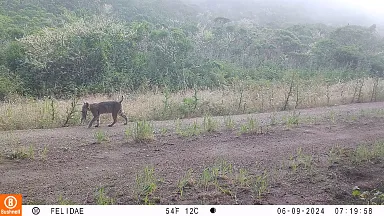Small Cat, Big Impact- The Ecological Role of Bobcats and the Threats They Face
The Bobcat (Lynx rufus) is one of North America’s most adaptable wild cats, occupying habitats like deserts and forests even to suburban edges. Roughly twice the size of a domestic cat, bobcats are important as mesopredators, helping to regulate small prey populations and maintain a balanced ecosystem.
Bobcats mainly feed on rabbits, rodents, and birds and so as predators they help to control and regulate prey populations. In places where the apex predator is absent or has significantly declined, they may even take the apex role (Prugh et al. 2009). Ongoing research in the San Francisco Bay Area by Felidae’s Bay Area Bobcat Project has revealed that bobcats can persist and adapt to fragmented and semi-urban habitats, preying on rodents and serving as a form of pest control.
Despite their adaptability, bobcats face several human-induced threats. Habitat fragmentation from urban development forces them to navigate roads and human-dominated landscapes, increasing the risk of collisions with vehicles (Riley et al. 2006). Rodenticide poisoning is also a growing concern. Research in California suggests that exposure to anticoagulant rodenticides is widespread. Specifically, researchers found that 90% of bobcats sampled showed evidence of rodenticides exposure in their tissues (Serieys et al. 2015). These chemicals can impair blood clotting and weakens the immune system, leaving the cats more susceptible to diseases such as mange (Riley et al. 2010).
Climate change adds additional pressures to bobcats. Increasing wildfire frequency and shifts in precipitation patterns are expected to alter habitat availability and connectivity (Moritz et al. 2012). In some areas, these changes could restrict the bobcat range or push them to less suitable areas, increasing the likelihood of conflict with humans.
Conservation and management strategies for bobcats include maintaining and restoring wildlife corridors, reducing the use of rodenticides, and monitoring populations through field surveys and camera trap studies (e.g. Serieys et al. 2021). In urban and suburban areas, public awareness campaigns are also critical to educate people about the impacts of rodenticides on non-target wildlife, thereby encouraging human-wildlife coexistence (Clark et al. 2011).
Bobcat presence benefits ecological and human health. Protecting this species will require proactive management to address habitat connectivity, toxin exposure, and changing climate conditions.

References
Clark, H.O., 2011. Urban carnivores: ecology, conflict, and conservation. Western North American Naturalist, 70(4), pp.577-578.
Moritz, M.A., Parisien, M.A., Batllori, E., Krawchuk, M.A., Van Dorn, J., Ganz, D.J. and Hayhoe, K., 2012. Climate change and disruptions to global fire activity. Ecosphere, 3(6): 1-22.
Prugh, L.R., Stoner, C.J., Epps, C.W., Bean, W.T., Ripple, W.J., Laliberte, A.S. and Brashares, J.S., 2009. The rise of the mesopredator. Bioscience, 59(9), pp.779-791.
Riley, S.P., Bromley, C., Poppenga, R.H., Uzal, F.A., Whited, L. and Sauvajot, R.M., 2007. Anticoagulant exposure and notoedric mange in bobcats and mountain lions in urban southern California. The Journal of Wildlife Management, 71(6), pp.1874-1884.
Riley, S.P., Pollinger, J.P., Sauvajot, R.M., York, E.C., Bromley, C., Fuller, T.K. and Wayne, R.K., 2006. FAST‐TRACK: A southern California freeway is a physical and social barrier to gene flow in carnivores. Molecular ecology, 15(7), pp.1733-1741.
Serieys, L.E., Armenta, T.C., Moriarty, J.G., Boydston, E.E., Lyren, L.M., Poppenga, R.H., Crooks, K.R., Wayne, R.K. and Riley, S.P., 2015. Anticoagulant rodenticides in urban bobcats: exposure, risk factors and potential effects based on a 16-year study. Ecotoxicology, 24(4), pp.844-862.
Serieys, L.E., Rogan, M.S., Matsushima, S.S. and Wilmers, C.C., 2021. Road-crossings, vegetative cover, land use and poisons interact to influence corridor effectiveness. Biological Conservation, 253, p.108930.
Do You Have 2-4 Hours A Month To Preserve Your Local Ecosystem?
Our volunteers are the driving force behind making true change in ecosystem health and wild cat conservation. Some like to volunteer in the field, others help us maintain our online presence, and some work with events. With just a few hours a month, you can make a difference, too.
Make A Difference Right Now
As a 501(c)3 nonprofit, our work is only possible because of generous donors like you.
More than 90% of your donation will go directly to our groundbreaking research, outreach, and education programs.
This is where true change starts. If you’d like to be a part of it, make a donation to Felidae Conservation Fund today:
Or,
